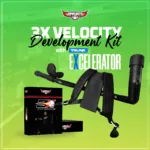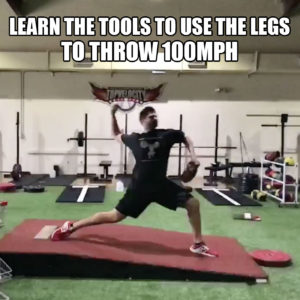 Are you searching for the knowledge on Analyzing Lower Half Pitching Mechanics? Then this is the article for you!
Are you searching for the knowledge on Analyzing Lower Half Pitching Mechanics? Then this is the article for you!
In the fast-paced world of competitive baseball, the mechanics of pitching are more than just a sequence of motions; they are the cornerstone of a pitcher’s effectiveness and longevity in the sport. Among these mechanics, the lower half of the pitcher’s body plays a pivotal role, acting as the foundational base from which power and precision are harnessed and delivered. This article delves deep into the analysis of lower half pitching mechanics, focusing specifically on the impact of peak horizontal ground reaction forces (GRF) and their corresponding impulses. These forces are instrumental in determining how energy flows through a pitcher’s body during the critical moments of a pitch.
By examining the intricate relationships between GRF and segmental energy flow, we can uncover valuable insights that are applicable not only to youth baseball players but also to professionals aiming to optimize their performance and mitigate injury risks. Whether you are a coach, a player, or a sports science enthusiast, understanding these biomechanical dynamics offers a unique perspective on how to enhance pitching efficiency through scientifically-backed methods. Join us as we explore the subtleties of these forces and their profound implications on the art and science of pitching.
Understanding Ground Reaction Forces in Pitching
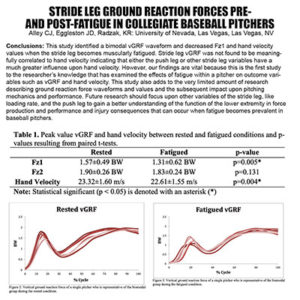 Ground reaction forces (GRF) play a critical role in the biomechanics of baseball pitching, acting as essential indicators of how a pitcher interacts with the ground to generate power and stability. These forces are not only fundamental for achieving high velocities but also for maintaining the structural integrity of the body during the intense act of pitching.
Ground reaction forces (GRF) play a critical role in the biomechanics of baseball pitching, acting as essential indicators of how a pitcher interacts with the ground to generate power and stability. These forces are not only fundamental for achieving high velocities but also for maintaining the structural integrity of the body during the intense act of pitching.
Peak GRF and its Role in Pitching Mechanics: Analyzing Lower Half Pitching Mechanics
Peak ground reaction force refers to the maximum force exerted by the ground on the pitcher’s body during the pitching action. This peak occurs when the pitcher’s foot makes firm contact with the mound and begins the forward drive that propels the arm whip. The magnitude and direction of this peak force can significantly influence the energy transfer throughout the body, impacting everything from the velocity of the pitch to the stress placed on the joints.
In pitching mechanics, peak GRF serves as the starting point for the kinetic chain—a sequence of events where energy is transferred through the body segments, culminating in the release of the ball. The efficiency of this energy transfer largely depends on the timing and magnitude of the peak GRF. For instance, higher peak GRFs are often associated with greater pitching velocities, assuming the pitcher can effectively manage this force through proper body mechanics and timing.
The Impact of GRF Impulse on Pitching: Analyzing Lower Half Pitching Mechanics
GRF impulse is another crucial aspect, referring to the overall effect of ground reaction forces over the time they are applied. It is calculated by integrating the force over the contact period and provides a more holistic view of how force is utilized throughout the pitching motion. The impulse gives insight into the pitcher’s ability to maintain force over time, which is vital for a powerful and controlled pitch.
The significance of GRF impulse lies in its relationship with momentum and energy efficiency. A higher impulse generally indicates a more sustained force application, leading to increased momentum transfer from the lower body through the trunk to the arm. Effective management of this impulse can help a pitcher maximize energy efficiency and pitch speed while minimizing the risk of fatigue and injury.
In essence, understanding and optimizing both peak GRF and GRF impulse are paramount for pitchers aiming to enhance their performance safely. By studying these forces, coaches and athletes can refine pitching techniques to achieve optimal energy transfer and improve overall mechanics, leading to better performance and reduced injury risk.
The Kinetic Chain in Pitchers: Analyzing Lower Half Pitching Mechanics
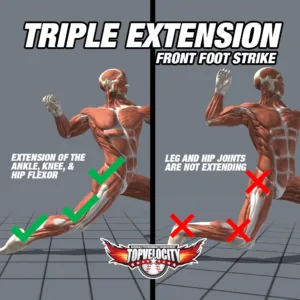 The concept of the kinetic chain in pitchers refers to the interconnected and coordinated movement of body segments that contribute to the pitching action. This chain begins at the pitcher's feet, moves up through the legs and hips, continues through the torso and shoulders, and ends in the arm and hand that release the ball. Understanding and optimizing the kinetic chain is vital for maximizing performance and reducing the risk of injury in pitchers.
The concept of the kinetic chain in pitchers refers to the interconnected and coordinated movement of body segments that contribute to the pitching action. This chain begins at the pitcher's feet, moves up through the legs and hips, continues through the torso and shoulders, and ends in the arm and hand that release the ball. Understanding and optimizing the kinetic chain is vital for maximizing performance and reducing the risk of injury in pitchers.
Segmental Energy Flow and Its Importance: Analyzing Lower Half Pitching Mechanics
Segmental energy flow describes how energy is transferred through various body segments during a pitch. This flow is crucial for efficient pitching as it affects both the velocity and control of the pitch. Proper segmental energy flow ensures that energy generated from the ground up is effectively transferred through each segment of the body before culminating in the release of the ball.
The importance of segmental energy flow can be likened to a well-oiled machine where each part must move in sync and with optimal timing to maximize efficiency. In pitching, this means each body segment should activate in a sequence that maximizes the conservation and transfer of kinetic energy. For example, a pitcher must stabilize their core as they initiate the leg drive, ensuring that the energy from the legs can effectively transfer through a stable trunk to the arm. Disruptions or inefficiencies in this flow can lead to reduced pitch velocity, decreased accuracy, and increased stress on individual body parts, potentially leading to injuries.
Roles of the Back and Front Legs in Pitching Mechanics: Analyzing Lower Half Pitching Mechanics
In the kinetic chain of pitching, the roles of the back and front legs are distinctly different yet equally critical. The back leg, often referred to as the drive leg, initiates the pitching motion. It generates the initial ground reaction forces necessary for the subsequent actions. The strength and stability of the drive leg are crucial for the forceful push-off required to start the kinetic chain. This leg's action is predominantly about generating forward linear momentum, which will be harnessed and amplified as the motion progresses up the chain.
On the other hand, the front leg acts as the stabilizer and decelerator once the pitcher steps forward into the pitch. As the pitcher transfers their weight from the back leg to the front leg, the front leg absorbs and manages the considerable kinetic energy rushing forward. This leg's role includes braking the forward momentum and providing a stable base from which the upper body can rotate and whip forward to deliver the pitch. The effective action of the front leg is essential for maintaining balance and directing the energy flow upwards towards the trunk and throwing arm, rather than dissipating it through unnecessary movement.
Together, the coordinated actions of the back and front legs form a crucial foundation for the successful execution of the pitching motion. Their roles in generating and managing kinetic energy underscore the importance of lower-body mechanics in achieving optimal pitching performance. By focusing on strengthening these elements and ensuring proper technique, pitchers can enhance their efficiency, power, and safety on the mound.
Biomechanical Analysis of Professional Pitchers: Analyzing Lower Half Pitching Mechanics
 Biomechanical analysis offers a detailed look into the mechanics of pitching, providing crucial insights that help improve performance and prevent injuries. This analytical approach examines how professional pitchers utilize their bodies in more refined and effective ways compared to their less experienced counterparts. By studying professional pitchers, coaches and biomechanists can identify key elements that contribute to superior performance and durability.
Biomechanical analysis offers a detailed look into the mechanics of pitching, providing crucial insights that help improve performance and prevent injuries. This analytical approach examines how professional pitchers utilize their bodies in more refined and effective ways compared to their less experienced counterparts. By studying professional pitchers, coaches and biomechanists can identify key elements that contribute to superior performance and durability.
Case Studies: How Pros Utilize GRF
Ground reaction forces (GRF) are critical in the biomechanics of pitching. Professional pitchers are often distinguished by their ability to optimize these forces for better performance. Case studies of professional pitchers reveal how subtle variations in their pitching mechanics, such as foot placement, leg strength, and the timing of their leg kicks, can significantly influence the magnitude and effectiveness of GRF.
For instance, a case study might focus on a pitcher renowned for his fastball velocity. Through motion capture technology and force plate data, analysts can observe how his drive leg generates peak GRF and how this correlates with the rapid acceleration of his pitching arm. Such studies often find that peak GRF occurs in a tightly controlled window that aligns perfectly with other kinetic events in the pitching sequence, allowing for maximum energy transfer and velocity.
Additionally, these case studies also examine the recovery and stabilization role played by the stride (front) leg, observing how professionals manage to transform high kinetic energy into a controlled pitching motion. This provides valuable insights into how different styles of leg use and body alignments affect pitching mechanics and outcomes.
Comparative Analysis of Youth and Professional Pitchers
A comparative analysis between youth and professional pitchers can illuminate the development paths and mechanical efficiencies that separate amateur from elite performance. This analysis looks at various aspects, including how each group manages GRF, the smoothness of their kinetic chains, and their overall energy efficiency.
Youth pitchers often display less optimized biomechanical patterns. Their ground reaction forces may be less focused, and their kinetic chain less coordinated, often due to underdeveloped physical conditions or technical expertise. In contrast, professional pitchers show highly refined mechanics that maximize both the generation and use of GRF. They typically exhibit stronger, more stable leg actions and more synchronized movements throughout the pitching motion.
This type of analysis is particularly beneficial for developing training programs aimed at young pitchers. By understanding the biomechanical differences, coaches can tailor training to address specific inefficiencies. For example, younger pitchers can be taught to improve their leg strength and coordination, which are crucial for enhancing GRF management and overall pitching mechanics.
The insights gained from analyzing professional pitchers not only enhance our understanding of effective pitching but also serve as a valuable educational tool. They provide a clear pathway for young athletes aspiring to reach higher levels of performance, emphasizing the critical role of biomechanics in achieving pitching excellence.
Training Techniques for Optimizing Pitching Mechanics

Effective training techniques are essential for developing and optimizing pitching mechanics. These techniques not only improve performance but also play a crucial role in injury prevention. Through targeted drills and the integration of advanced technology, pitchers can enhance their mechanics, leading to better control, velocity, and overall pitching efficiency.
Drills to Enhance Lower Half Mechanics
The lower half of the body is fundamental in generating the power needed for pitching. Drills that focus on enhancing the strength, stability, and coordination of the lower half are vital. Here are some effective drills:
- Leg Drive Drills: These drills focus on strengthening the pitcher's back leg, which is crucial for initiating the kinetic chain and generating the necessary force to drive the pitch. Exercises like squats, lunges, and leg presses can be adapted to mimic the pitching motion, enhancing the functional strength of the drive leg.
- Balance and Stability Drills: Stability is key in transferring the generated force effectively through the body without energy loss. Balance drills, such as single-leg stands or stability ball exercises, help pitchers improve their control over their body movements during the pitch.
- Dynamic Stretching and Mobility Drills: Flexibility and range of motion in the hips and legs allow for a fuller and more powerful leg action. Dynamic stretching routines before practices and games can enhance mobility, reducing the risk of injuries and improving the effectiveness of the leg drive.
- Plyometrics: Plyometric exercises like jump squats or box jumps improve explosive strength and speed in the legs. These exercises help pitchers develop the quick, powerful movements needed during the pitching process.
These drills are designed not just to enhance physical capabilities but also to integrate these improvements into the specific context of pitching. Regular practice leads to a more efficient and powerful pitch, driven by a strong and stable lower body.
The Role of Technology in Analyzing Pitching Mechanics
In recent years, technology has become a pivotal tool in analyzing and enhancing pitching mechanics. Advanced devices and software are now regularly used to provide detailed feedback on a pitcher's form and technique, allowing for precise adjustments. Key technologies include:
- High-Speed Video Analysis: By recording the pitching motion with high-speed cameras, coaches and biomechanists can break down the mechanics frame-by-frame to identify areas of inefficiency or potential risk for injury. This visual feedback is invaluable for pitchers to understand and correct their form.
- Wearable Sensors: Devices like accelerometers and gyroscopes can be attached to a pitcher’s body to measure various parameters such as velocity, spin rate, and angle of release. These sensors provide real-time data that can be used to fine-tune mechanics for optimum performance.
- Force Plates: These measure the forces exerted by the feet during the pitching motion, providing insights into how effectively a pitcher is using their legs to generate power. Understanding these dynamics allows for targeted improvements in foot positioning and weight transfer.
- Biomechanical Software: Software that integrates data from video, sensors, and force plates can create comprehensive models of a pitcher’s mechanics. This integration allows for a holistic analysis of performance and the development of personalized training and correction plans.
The integration of these technological tools into training regimes has revolutionized the way pitching mechanics are taught and refined. They enable a level of precision and personalization previously unattainable, ensuring that each pitcher can achieve their maximum potential while minimizing the risk of injury.
Enhancing Lower Half Mechanics with Top Tools
In the competitive world of baseball, achieving and maintaining peak performance is paramount. Two standout tools have revolutionized how athletes develop their lower half mechanics, crucial for pitching velocity and overall effectiveness on the mound: the "King of the Hill" Trainer and the 3X Velocity Development Kit with Stride Excelerator.
 "King of the Hill" Trainer
"King of the Hill" Trainer
The "King of the Hill" Trainer is not just a tool but a comprehensive program designed to dramatically enhance pitching velocity. For a total cost of $409, including shipping (additional fees apply for Hawaii and Canada), this trainer offers unparalleled value.
Benefits and Features:
- Revolutionary Velocity Development Program: This trainer comes with the 3X Pitching Velocity Program, which can add up to 5 mph or more to your fastball. It's designed to increase the effectiveness of your leg drive, a crucial element in maximizing pitching velocity and reducing arm stress.
- Biomechanical Efficiency: The trainer encourages pitchers to develop a strong, effective leg drive off the mound, increasing the separation between the upper and lower body. This separation enhances the transfer of elastic energy through the core, enabling faster arm speed and higher velocity at release.
- Scientifically Supported: The effectiveness of the "King of the Hill" Trainer is backed by studies, including those by Kibler and Chandler, which show the critical role of kinetic energy from the hip and trunk in reducing shoulder rotational velocity and stress.
What’s Included:
- 3X Pitching Mechanics and Science
- 3X Pitching Velocity Drills tailored for the "King of the Hill"
- 3X PITCH BioMetrics
- 3X Pitching Velocity Training Calendar
- 3X Pitching Instructional Video Library
This training package, valued at over $500, is currently utilized at various levels from high school to professional, proving its efficacy in not only boosting velocity but also in promoting long-term arm health.

 3X Velocity Development Kit with Stride Excelerator
3X Velocity Development Kit with Stride Excelerator
The 3X Velocity Development Kit with Stride Excelerator offers a holistic approach to enhancing pitching performance through focused lower-half training.
Key Features and Benefits:
- State-of-the-Art Training Tool: The Stride Excelerator is engineered to optimize lower-half mechanics, crucial for adding more than 5 mph to your pitching velocity. It focuses on developing elite movements that enhance velocity and minimize injury risk.
- Comprehensive Training Program: Included with the kit are detailed drills and exercises specifically designed to maximize the effectiveness of the Stride Excelerator. These resources teach proper techniques to unlock power and improve pitching performance.
- Instructional Support: The kit comes complete with instructional videos that provide a visual guide to mastering the exercises and ensuring your training is as effective as possible.
What’s Included:
- The Stride Excelerator Device
- A full suite of training materials
- Access to an extensive video library for ongoing learning and development
This kit not only boosts performance on the mound but also enhances throwing capabilities for position players, making it an invaluable tool for anyone looking to dominate in baseball.
Both the "King of the Hill" Trainer and the 3X Velocity Development Kit with Stride Excelerator stand as the pinnacle of pitching development tools. They cater to athletes who are serious about using their lower half effectively to enhance performance and maintain arm health. By investing in these tools, pitchers can expect substantial improvements in velocity and pitching mechanics, setting them apart in the highly competitive arena of baseball. Order today and begin your journey to becoming a powerhouse pitcher with cutting-edge training at your fingertips.
For more exclusive content visit TopVelocity Patreon!


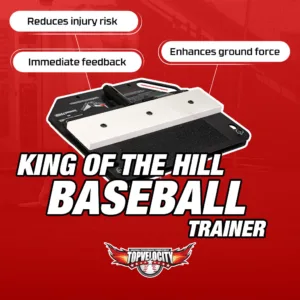 "King of the Hill" Trainer
"King of the Hill" Trainer